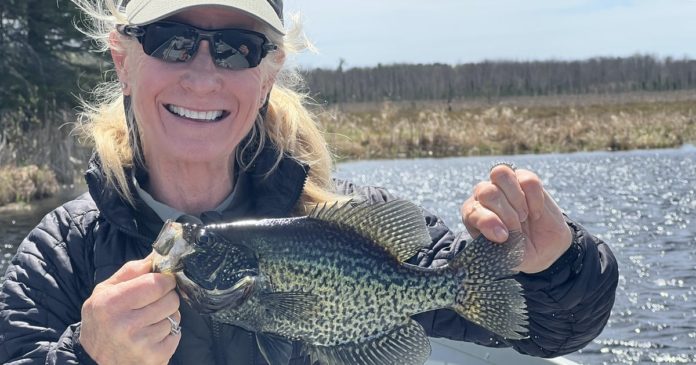Two questions about the designation in 1965 by the Legislature of the walleye as the state fish:
One, why did it take so long?
And two — and more relevant to today’s discussion — why was the walleye chosen instead of the crappie? Or, for that matter, the “sunfish,” a catch-all term that in Minnesota includes green sunfish, orange-spotted sunfish, bluegills, pumpkinseed, northern sunfish, warmouth and the hybrids thereof?
Which, after all, is more fun to fish for and/or catch: Sunnies and crappies — or walleyes?
Of course, the answer to this last question is, “It depends on the time of year.”
Meaning that in spring and early summer, when panfish (another catch-all term that for present purposes means “sunnies and crappies”) are in shallow water, they are by far among the most “fun” fish to seek, besting not only walleyes in that respect, but most if not all other Minnesota game fish.
The reason: Crappie and sunnie action in springtime can be so fast that sometimes bait isn’t even required to trigger a bite. Oftentimes a small tube jig with a bare hook, or even a colored jig sans a tube, is all an angler needs to catch these tasty morsels.
I was thinking about this the day before the walleye opener, when my wife, Jan, and I stopped en route to Winnibigoshish for a couple of hours of crappie fishing.
This was as much her idea as mine, in part because her late mother, Odile “Sunny” Netko, was an avid panfish angler, and in that respect the two were cut from the same cloth.
Sunny, in her later years, suffered from macular degeneration and was legally blind. But when Jan and I took her out on the Whitefish Chain, where she had a cabin, she could see a bobber on her line if she dropped it directly over the side of my boat and if she draped herself over the gunwale to get as close to the water as possible without falling in.
Her poor vision notwithstanding, she knew how to set the hook when her bobber disappeared. And set it she did.
On the day before the walleye opener, due to high winds, Jan and I were forced to fish for crappies on the lee side of the lake we had chosen. In these early tries we had no luck, and for a while it appeared we would leave fishless.
Then, on a bit of a lark, trying a distant spot, we found a honey hole that kept us busy catching and releasing crappies for about 30 minutes.
So fast was the action that one time I took a video of Jan casting, with the intention of focusing then on her bobber to watch it go down, before Jan set the hook.
But the bobber went subsurface even before I could locate it in the viewfinder.
As a kid, my first experiences with springtime crappie action were in the Perham-Frazee-Vergas area. My grandfather was a Methodist minister serving churches in each of those towns, and when we visited in summer, my brother, Dad and I — in addition to hearing the same sermon three times on Sundays — would hit one of the many nearby panfish lakes and oftentimes return with limits of crappies and sunnies.
I also feasted on crappies, big ones, when Upper Red was experiencing its crappie explosion. Also some years ago, Dave Vesall, the retired DNR (and its predecessor, the Department of Conservation) fish and game chief and I fished springtime sunnies and crappies with fly rods, casting small poppers to pencil reeds while standing in knee-deep water, wearing waders.
When Pelican Lake, near Orr, was going fast and furious with sunnie action quite a few years ago, I also joined Dave and Betty there a couple of times.
As further evidence of the hold that sunnies and crappies can have on anglers, consider that a few years back, when Jan’s mom was in a nursing home, Jan and our two sons stopped to see her on the way home from a springtime crappie and sunnie outing.
By then grandma couldn’t see much of anything, but she smiled as if she were given a new set of eyes when the boys brought their catch of crappies to her room and held one within inches of her face so she could make out its outline, and touch.
She was happier still when the boys fried up a few crappies for her lunch, employing a portable cooker outside.
Yet for all the angling pleasure sunnies and crappies provide, issues remain regarding each. Primary is that they are overfished, due in large part, historically, to limits that were too liberal.
Attempting to rectify this, and to grow bigger sunnies and crappies, DNR managers in recent years have reduced limits of each. Here, a careful reading of the fisheries regulations is required, because special sunnie and/or crappie harvest restrictions now apply to as many as 250 lakes, including 52 that were added this spring under the DNR’s Quality Sunfish Initiative.
Andrew Lake in Douglas County, for example, has a daily sunfish limit of 10, while Annie Battle Lake in Otter Tail County has a possession limit of five sunnies.
Regarding crappies, five with a minimum size of, say, 10 inches, should be enough for any individual angler to keep from an outing. Ditto, depending on their size, sunfish.
Such restraint, as enforced increasingly by DNR regulations, should, over time, boost the average size of these wonderful, delicious, fish — thereby ensuring that future generations of anglers can make, and relish, sunnie and crappie memories of their own.
Credit: Source link






























